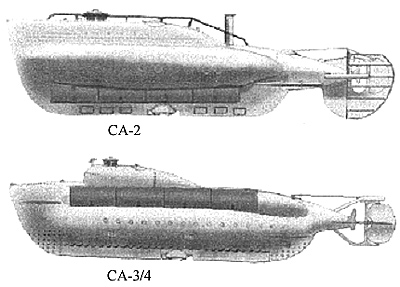
From the beginning of 1940 until the end of 1944, the well known 12th U-Bootflottille was based at Bordeaux. In addition to the big German U-Boats such as the Type IX-D1, IX-D2 and X-B, there were also the bigger Italian submarines on the IX Italian Group. Among the approximately four hundred submarines that fought the Battle of the Atlantic, thirty-two Italian submarines participated along with the German U-Boats.
We will cover their exploits on these pages over the next many issues, but now we look at construction of some Italian submarines.
Mini Submarine CA Class
With a crew of only two men, these mini-submarines were built in 1938 with two diesel engines and two electric motors. They had an operational periscope and carried two torpedoes.
In 1941, CA 1 and CA 2 were modified at Decima MAS Flotilla to use them to transport underwater commandoes into enemy harbors. This meant the removal of the diesel engines and the periscopes. In these two submarines, the torpedoes were replaced with eight explosive charges of about 100 kilograms (about 220 pounds) and with these modifications, could carry three frogmen.
In the sea trials in September 1942 from the mother submarine DA VINCI in the Atlantic, they found that the modified mini-subs were not strong enough to safely carry the explosive charges, so they were taken back into the yards for more work. Now CA 2 went into the shipyard at Bordeaux, where the explosive charges were placed in a stronger part of the little boat.
Specifications of the CA 2 mini submarine are:
- Displacement 12/14 tons
- Length 10 meters (about 33 feet)
- Beam 1.9 meters (about 6 feet
- Speed (surfaced) 7 knots
- Speed (submerged) 6 knots
- Propulsion single electric motor of 21kw
- Range 70 miles at 2 knots submerged
- Armament eight explosive charges
- Crew eight men
This time the modifications worked well, so CA 3 and CA 4 were put on the planning boards. When Italy capitulated in 1943, CA 2 was taken over by the Germans (Kriegsmarine) at Bordeaux.
The CA 3 and CA 4 mini-submarines wee designed to carry a bit more tonnage, although the dimensions remained quite similar to the CA 2 so they could fit on the deck of the mother submarine. The two major changed from CA2 to CA3 and CA4 were smoother hull shape and simplified rudder arrangement. This did not increase their speed through the water appreciably, but it did reduce the wake of the boat through the water and thereby, reducing their visibility in the deeper waters.
CA 3 and CA 4 were operational and their crews training to attack New York or Freetown harbors, probably in December 1943. But Italy capitulated in September of 1943, and so these plans never materialized. The two boats were scuttled by their crews, but they were salvaged later on.
Note the more streamlined shape of the CA 3 and CA 4 below as compared to the earlier CA 2.
Thanks again VINCENT, for the great information on the Italian submarines during World War II. This is a portion of the war at sea that is not touch upon by many because the information is not easily available. Thanks to Members like VINCENT, we get it correct and we publish this information for all history.
Back to KTB # 170 Table of Contents
Back to KTB List of Issues
Back to MagWeb Master Magazine List
© Copyright 2003 by Harry Cooper, Sharkhunters International, Inc.
This article appears in MagWeb.com (Magazine Web) on the Internet World Wide Web. Other articles from military history and related magazines are available at http://www.magweb.com
Join Sharkhunters International, Inc.: PO Box 1539, Hernando, FL 34442, ph: 352-637-2917, fax: 352-637-6289, www.sharkhunters.com
